Parasite-specific IL-17-type cytokine responses and soluble IL-17 receptor levels in Alveolar Echinococcosis patients
- PMID: 22969818
- PMCID: PMC3437316
- DOI: 10.1155/2012/735342
Parasite-specific IL-17-type cytokine responses and soluble IL-17 receptor levels in Alveolar Echinococcosis patients
Abstract
Alveolar Echinococcosis (AE) caused by the cestode Echinococcus multilocularis, is a severe helminth infection of man, where unrestricted parasite growth will ultimately result in organ failure and fatality. The tissue-infiltrative growth of the larval metacestode and the limited efficacy of available drugs complicate successful intervention in AE; patients often need life-long medication, and if possible, surgical resection of affected tissues and organs. Resistance to AE has been reported, but the determinants which confer protection are not known. ln this study, we analyzed in patients at distinct stages of Alveolar Echirococcosis, that is cured, stable and progressive AE, as well as in infection-free controls, the cellular production and plasma levels of pro-inflammatory cytokines lL-17A, lL-17B, lL-17F and their soluble receptors lL-17RA (slL-17RA) and IL-17RB (sIL-17RB). Significantly elevated levels of IL-17B and slL-17RB were observed, whilst lL-17F and slL-17RA were reduced in patients with AE. Similarly, the cellular production of lL-17F and slL-L7RA in response to E. multilocularis antigens was low in AE patients, while levels of slL-17RB were highly enhanced. These observations suggest immune-modulating properties of E. multitocularis on lL-17 cytokine-mediated pro-inflammatory immune responses; this may facilitate the tissue infiltrative growth of the parasite and its persistence in the human host.
Figures
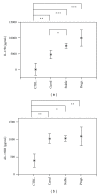
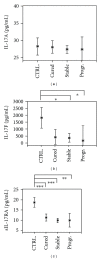
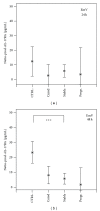
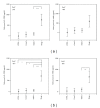
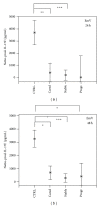
Similar articles
-
Distinctive cytokine, chemokine, and antibody responses in Echinococcus multilocularis-infected patients with cured, stable, or progressive disease.Med Microbiol Immunol. 2014 Jun;203(3):185-93. doi: 10.1007/s00430-014-0331-8. Epub 2014 Feb 9. Med Microbiol Immunol. 2014. PMID: 24509604
-
Echinococcus multilocularis: inflammatory and regulatory chemokine responses in patients with progressive, stable and cured alveolar echinococcosis.Exp Parasitol. 2008 Aug;119(4):467-474. doi: 10.1016/j.exppara.2008.04.006. Epub 2008 Apr 14. Exp Parasitol. 2008. PMID: 18490012
-
Deletion of Fibrinogen-like Protein 2 (FGL-2), a Novel CD4+ CD25+ Treg Effector Molecule, Leads to Improved Control of Echinococcus multilocularis Infection in Mice.PLoS Negl Trop Dis. 2015 May 8;9(5):e0003755. doi: 10.1371/journal.pntd.0003755. eCollection 2015 May. PLoS Negl Trop Dis. 2015. PMID: 25955764 Free PMC article.
-
Molecular survival strategies of Echinococcus multilocularis in the murine host.Parasitol Int. 2006;55 Suppl:S45-9. doi: 10.1016/j.parint.2005.11.006. Epub 2005 Dec 13. Parasitol Int. 2006. PMID: 16352460 Review.
-
Immunoregulation in larval Echinococcus multilocularis infection.Parasite Immunol. 2016 Mar;38(3):182-92. doi: 10.1111/pim.12292. Parasite Immunol. 2016. PMID: 26536823 Review.
Cited by
-
The correlations between Th1 and Th2 cytokines in human alveolar echinococcosis.BMC Infect Dis. 2020 Jun 15;20(1):414. doi: 10.1186/s12879-020-05135-y. BMC Infect Dis. 2020. PMID: 32539714 Free PMC article.
-
Difficulties in the diagnosis and management of alveolar hydatid disease: A case series.Caspian J Intern Med. 2016 Winter;7(1):52-6. Caspian J Intern Med. 2016. PMID: 26958334 Free PMC article.
-
Understanding pathogen-host interplay by expression profiles of lncRNA and mRNA in the liver of Echinococcus multilocularis-infected mice.PLoS Negl Trop Dis. 2022 May 31;16(5):e0010435. doi: 10.1371/journal.pntd.0010435. eCollection 2022 May. PLoS Negl Trop Dis. 2022. PMID: 35639780 Free PMC article.
-
The Potential Role of Th9 Cell Related Cytokine and Transcription Factors in Patients with Hepatic Alveolar Echinococcosis.J Immunol Res. 2015;2015:895416. doi: 10.1155/2015/895416. Epub 2015 Oct 5. J Immunol Res. 2015. PMID: 26509179 Free PMC article.
-
Distinctive cytokine, chemokine, and antibody responses in Echinococcus multilocularis-infected patients with cured, stable, or progressive disease.Med Microbiol Immunol. 2014 Jun;203(3):185-93. doi: 10.1007/s00430-014-0331-8. Epub 2014 Feb 9. Med Microbiol Immunol. 2014. PMID: 24509604
References
-
- Piarroux M, Piarroux R, Giorgi R, et al. Clinical features and evolution of alveolar echinococcosis in France from 1982 to 2007: results of a survey in 387 patients. Journal of Hepatology. 2011;55(5):1025–1033. - PubMed
-
- Kern P. Clinical features and treatment of alveolar echinococcosis. Current Opinion in Infectious Diseases. 2010;23(5):505–512. - PubMed
-
- Gottstein B, Felleisen R. Protective immune mechanisms against the metacestode of Echinococcus multilocularis . Parasitology Today. 1995;11(9):320–326. - PubMed
-
- Vuitton DA. The ambiguous role of immunity in echinococcosis: protection of the host or of the parasite? Acta Tropica. 2003;85(2):119–132. - PubMed
Publication types
MeSH terms
Substances
Supplementary concepts
LinkOut - more resources
Full Text Sources

